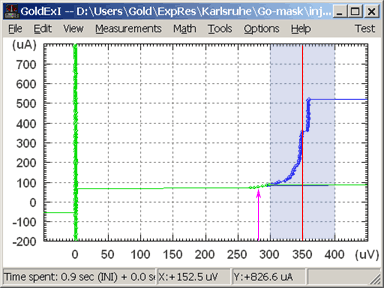![]()
![]()
How
do I measure maximum current of some step as a function of magnetic
field Im(H)?
Before proceeding further read about Ic(H) first.
In general Im(H) measurement works similar to Ic(H), but you have to specify a couple of additional parameters in options:
the voltage of the step Vstep,
the reset voltage VR.
As an example, let's consider the IVC shown on the following picture.

Those are actually two curves combined together (using File | Add):
the green curve was measured without using limits i.e. the bias current was swept from a large negative value to a large positive value and back. Note, that on the way back along McCumber branch one can trace the bottom of the step in which we are interested in.
the blue curve was measured starting the bias sweep from the bottom of the step upwards and then back. This can be done using limits in the IVC measurement window and by properly setting the initial value of the bias current before pushing DoIt button.
For our particular example the appropriate value for the voltage of the step Vstep is about 350 µV (shown by read line), and criterion dV is about 50 µV. The bias point is considered as being at the step when the voltage
Vstep-dV < V < Vstep+dV
This region is shown by the shadow in the above figure.
To start tracing the maximum current of the step, we should first make sure that the bias point is at the bottom of the step. The reset voltage basically shows where the bottom of the step is. In the example above the values of VR of about 270 µV (shown by magenta arrow) should be okay.
The whole algorithms works as follows. Being high at the McCumber branch GoldExI
decreases the bias current until the voltage V becomes smaller than reset voltage VR. (the step in bias is given by "Reset Searching Step" in Im(H) options)
Then GoldExI increases the current and checks whether the voltage V is below, above or at the step. If the voltage V is below or at the step, GoldExI keeps increasing the bias current. (the bias current step is given by "forward step" in Im(H) options)
If the voltage V is above the step and at the previous value of the bias current the voltage was at the step, then we have found Im at the current value of H. If at the previous value of the bias current the voltage was below the step, then we didn't visit the step and jumped directly from somewhere below the step (Meissner brunch? another low-voltage step?) to somewhere above the step. In the latter case GoldExI records Im = 0 for the current value of H.
Then the magnetic field is increased and the whole procedure is repeated from the very beginning.
Notes
The IVC shown in the above figure corresponds to H=0. For other values of H the shape of the step, including its bottom part, may change. It may also happen that for some values of field there are no stable points at or just below VR which lead to the the step of interest. In this case just after reset, the bias point will fall down to the lower laying step or to Meissner branch. In this case Im may be not traceable and you will see Im=0. This is normal. But anyway to reduce this effect, try to choose VR carefully.
The ideal VR is just below the point where McCumber branch and the step join together. But not that this point may depend on H.
For some IVCs the bias point jumps from the top of the step to lower voltage (instead of to higher voltage). For such IVCs Im(H) algorithm does not work. I tried to make it working within current algorithm but it is always ambiguous. In the options window in some versions of GoldExI you may find an option "jump from V_step to V<V_step is okay too", but up to now it does not work.
What are the differences between Ic(H) and Im(H) algorithms?
The above description of Im(H) is a bit rough. In reality Im(H) uses the same tricks as Ic(H) to accelerate the procedure. It does not scan the whole step from the bottom to the top, but tries the previous value of Im first. So all performance options apply to Im(H) too.
But, you cannot compensate for series resistance (not implemented) and use |V| instead of V (this makes no sense). The compensation for the series resistnace may be added in the future, but one should work with "resistor" lines not passing through origin, i.e. one will need two parameters. Write to me if you really need it.
See also: How to measure Ic(H).
![]()
[Review]
[Download]
[Gallery]
[Links]
[F.A.Q.]
[HerStory]
[Bugs]
[Suggestions]
[Author]
[EMDAQ.DLL] [Home]
[forum]
![]()
|
Designed
by Edward
Goldobin.
All Rights Reserved |
|